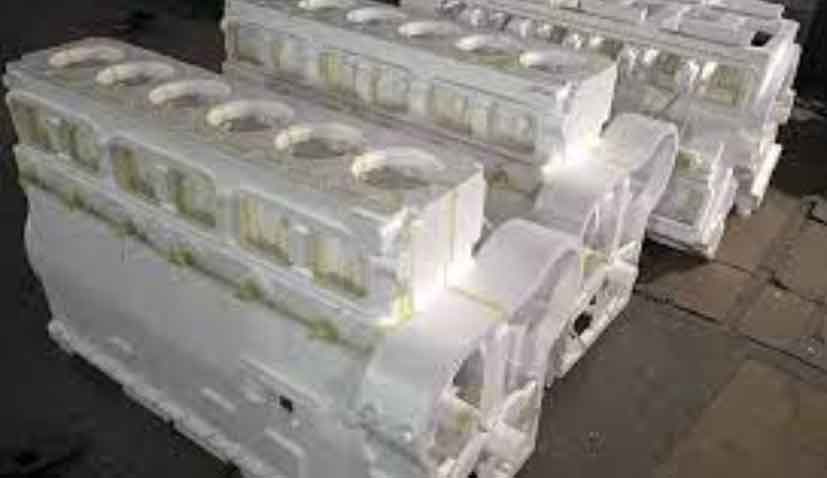Lost foam casting has revolutionized the metal casting industry by enabling complex geometries with exceptional dimensional accuracy. The white area – encompassing pattern creation, coating, and preparation – significantly influences final casting quality. This paper systematically analyzes equipment selection criteria, process parameter optimization, and workshop layout strategies for lost foam casting white areas.
1. Core Processes and Equipment Requirements
The white area production flow comprises six critical stages:
- Bead pre-expansion and aging
- Pattern molding
- Drying operations
- Pattern assembly
- Coating application
- Final drying

1.1 Bead Pre-expansion and Aging
Key parameters for EPS/STMMA bead processing:
| Parameter | EPS | STMMA |
|---|---|---|
| Pre-expansion density (g/L) | 18-22 | 20-25 |
| Aging time (h) | 6-8 | 4-6 |
| Moisture content (%) | <2.5 | <1.8 |
The moisture removal rate during aging follows:
$$ \frac{dM}{dt} = -k(M – M_e) $$
Where:
M = moisture content (%)
Mₑ = equilibrium moisture content
k = drying rate constant
1.2 Pattern Molding
Steam consumption for pattern molding can be calculated using:
$$ Q = \frac{m \cdot c_p \cdot \Delta T}{h_{fg}} $$
Where:
Q = steam required (kg)
m = bead mass (kg)
cₚ = specific heat (kJ/kg·K)
ΔT = temperature difference (K)
h_{fg} = latent heat of vaporization (kJ/kg)
2. Critical Equipment Selection
2.1 Drying Systems Comparison
| Type | Temperature Range (°C) | RH Control | Energy Efficiency |
|---|---|---|---|
| Steam Heating | 40-60 | ±5% | 0.7-0.8 |
| Heat Pump | 30-55 | ±2% | 3.5-4.5 |
| Electric Heating | 40-80 | ±8% | 0.95 |
2.2 Coating Application
The coating thickness (δ) should follow:
$$ \delta = \frac{\rho \cdot V}{A} $$
Where:
ρ = coating density (g/cm³)
V = coating volume (cm³)
A = pattern surface area (cm²)
3. Workshop Layout Optimization
Optimal lost foam casting white area layout must consider:
- Material flow efficiency
- Environmental control requirements
- Future expansion potential
Recommended multi-level layout parameters:
| Zone | Floor Height (m) | Temperature (°C) | Humidity (%) |
|---|---|---|---|
| Molding Area | 6-8 | 25-30 | 50-60 |
| Drying Area | 5-6 | 40-60 | 15-20 |
| Coating Area | 4-5 | 25-30 | 40-50 |
4. Advanced Process Control
For high-quality lost foam casting production, implement:
- Real-time moisture monitoring: $$ RH = \frac{e}{e_s} \times 100\% $$
- Automated adhesive application: $$ t_{cycle} = \frac{n \cdot t_{unit}}{N_{robots}} $$
- Intelligent thermal management: $$ \frac{\partial T}{\partial t} = \alpha \nabla^2 T $$
5. Energy Efficiency Considerations
Heat recovery potential in lost foam casting white areas:
$$ Q_{recovery} = \eta \cdot \sum_{i=1}^{n} (m_i \cdot c_{p,i} \cdot \Delta T_i) $$
Where:
η = heat recovery efficiency (50-70%)
m = mass flow rate (kg/h)
cₚ = specific heat capacity (kJ/kg·K)
ΔT = temperature difference (K)
6. Quality Control Metrics
| Parameter | Acceptance Criteria | Measurement Method |
|---|---|---|
| Pattern Dimensional Tolerance | ±0.3% | 3D Scanning |
| Coating Thickness | 0.8-1.2 mm | Ultrasonic Gauge |
| Final Moisture Content | <0.5% | Karl Fischer Titration |
This comprehensive approach to equipment selection and layout optimization ensures efficient lost foam casting production while maintaining strict quality standards. The integration of advanced thermal management systems and automated process controls significantly enhances the competitiveness of modern foundries in the era of Industry 4.0.
